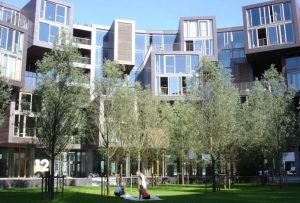Rooftop garden and free iPad: investing in student housing
 Universities are not able to provide all students with housing, private investors help to fill this gap
Universities are not able to provide all students with housing, private investors help to fill this gap
The globalization of higher education plays into the hands of investors. Student housing is becoming an increasingly attractive asset: over the past three years, the number of investors who evaluate investment prospects in this sector “as very good” has increased 2.5 times, according to data from the Statista portal. A characteristic feature of this sector is the so-called acyclicity: the number of students can grow both in times of crisis and in times of economic upturns.
According to Savills, in 2016, housing investment for students broke the record, reaching 16.4 billion dollars. In a PwC survey conducted among 800 of the largest investors in Europe, 32% of respondents said they are considering investing in student housing in the near future. . Types and features of student housing Under the student housing understand real estate objects that are leased exclusively to students. There are different types of student housing: dormitories, communal apartments with shared bathrooms and kitchens, or micro-apartment complexes. Such housing belongs to non-educational operators and is located outside the university, but in close proximity to them.
Copenhagen Hostel
Hostel in Copenhagen Jens Cederskjold / Wikimedia
By the type of services offered, they distinguish complexes operating on a hotel basis, and classic apartments with minimal service or without it at all. For example, in the first case, the price includes cleaning, linen change and breakfast. Student micro-apartment complexes consist of several furnished apartments of up to 35 m².
On the territory of student complexes, residents can offer laundry services, a fitness center, access to the swimming pool and a common recreation area, for example, with a roof garden. In addition, the owners and operators of such housing in order to attract students are ready to offer rental benefits, various discounts and bonuses, for example, free iPads for use in common areas.
Key markets
The largest market for student housing in the world is the United States. Two years ago, there were 20.3 million students in this country, of which 5% came into the country from abroad. According to Savills, the monthly cost of renting student housing in the United States ranges from $ 200 to 2.2 thousand, and the total investment in this sector in 2016 reached $ 9.8 billion. Rental income, which the investor can expect, is on average 5.9%.
In Europe, the leading positions belong to Germany, France, Great Britain and the Netherlands. In Germany, in the period 2016–2017, there were the largest number of students in Europe: almost 2.8 million people, 12% of whom are foreigners. Private investments in the German student housing market in 2016 amounted to 750 million euros, the volume of investments in 2017, according to preliminary estimates, exceeded 1 billion euros. The cost of renting student housing in this country starts from 200 euros and can reach 850 euros per month. According to Savills, the rental yield of student housing in Germany is on average 4%, which is slightly higher than the average rate of return of ordinary apartments at 3%.
Germany has become a champion in the growth of investment in the student housing sector: according to Savills, in 2016 the annual increase was 380%
Germany became the champion in the growth of investment in the student housing sector: according to Savills, in 2016 the annual increase was 380% runzelkorn / Depositphotos
In France and the UK, foreign students account for 12% and 19%, respectively, of the total number of students. In France, renting student housing is cheaper: from 200 to 1.2 thousand euros. In the UK, the cheapest offers on the rental market are comparable to European indicators, but the maximum values reach 2.3 thousand euros. The return on assets varies in the range of 4.0–4.5%, but slightly lower in London – 3.75%.
Data: Savills
Among other attractive European markets for investing in student housing, Savills experts point out Poland, Hungary, Portugal and the Czech Republic.
Micro-apartments – housing not only for students
Unlike ordinary apartments, which can be rented at any time of the year, student housing in small towns is characterized by seasonality of demand. Traditionally, settlement takes place closer to the fall and the start of the school year, and apartments are vacated in the summer.



